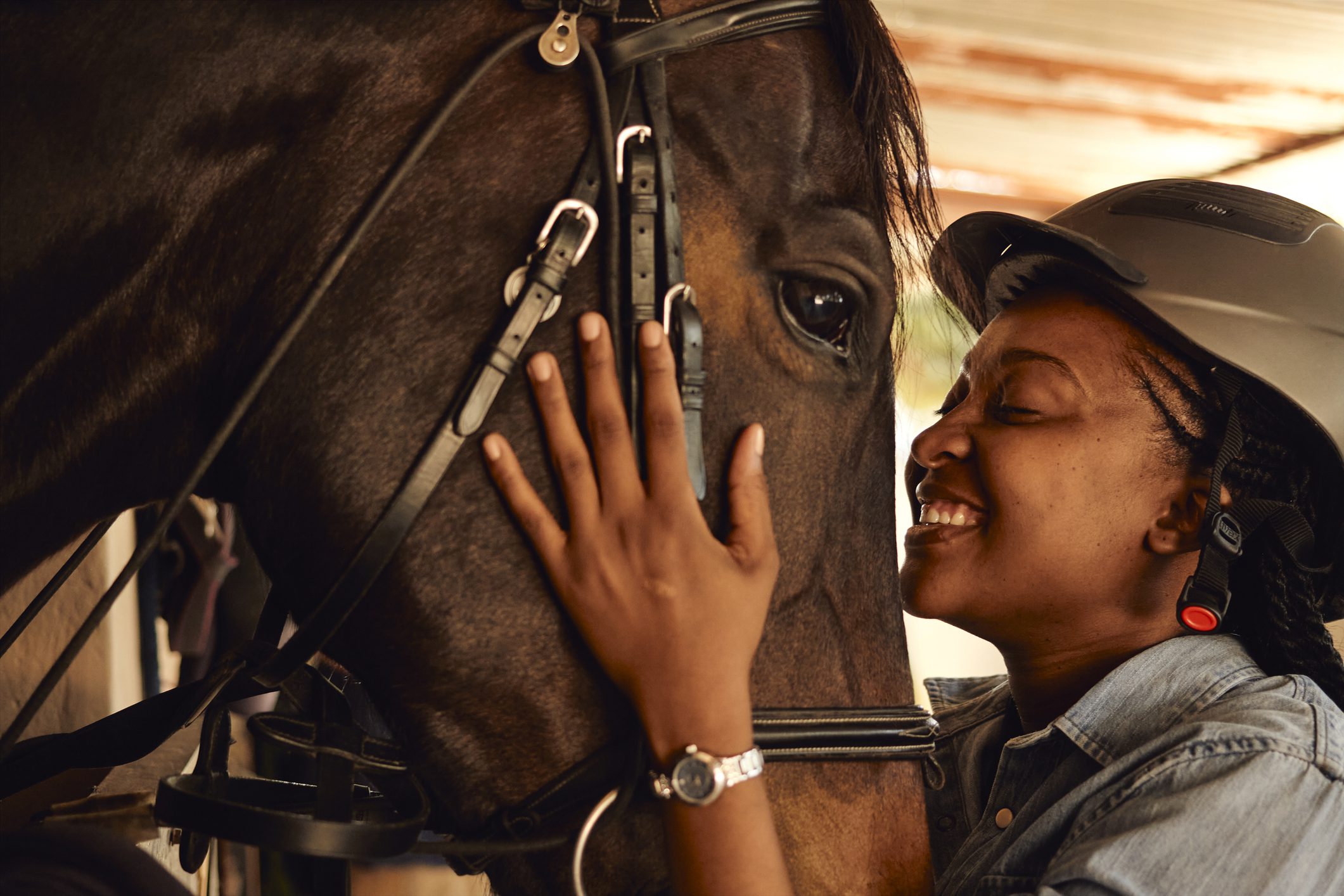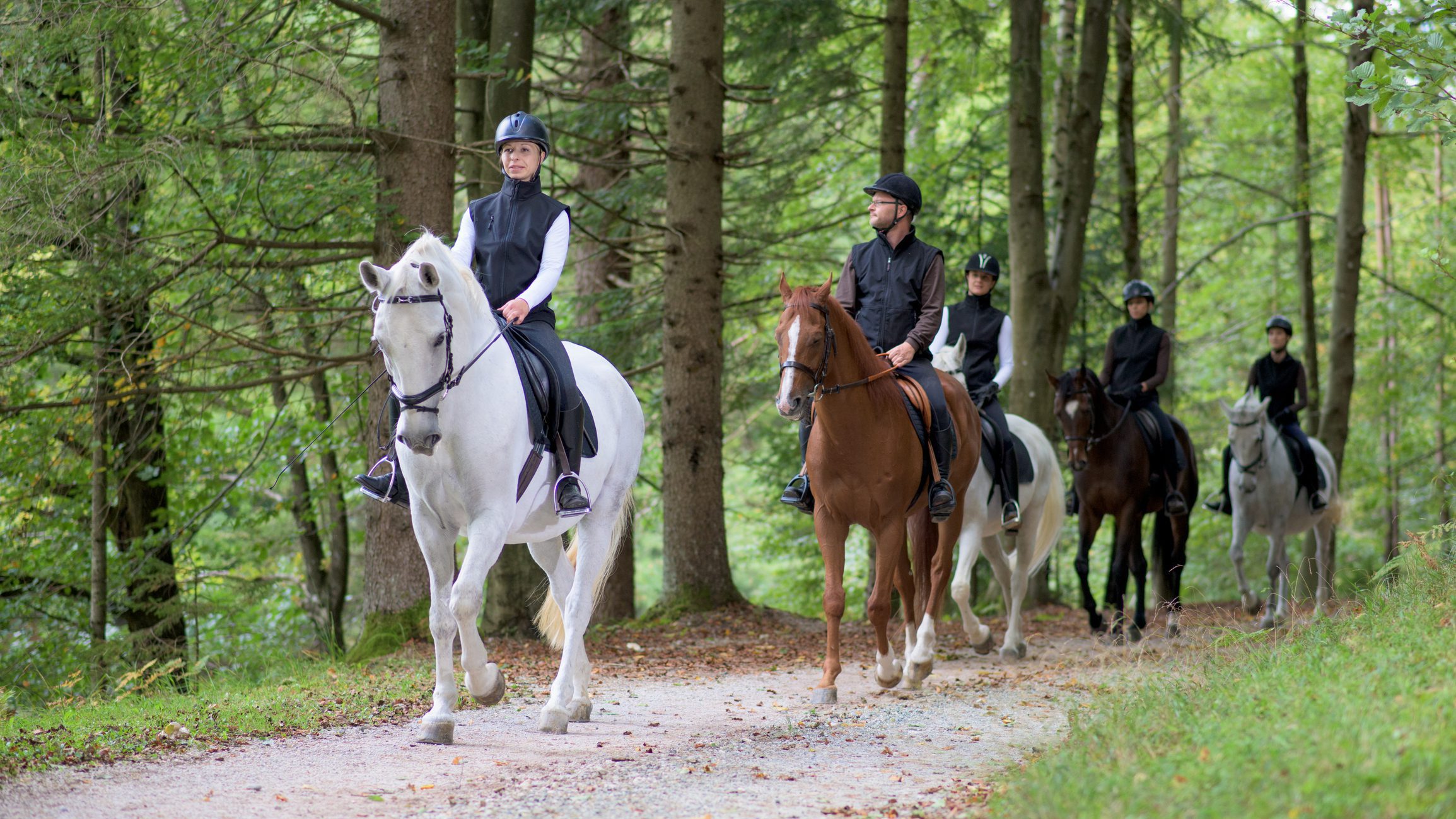Therapeutic Horse Riding Therapy for Adults
Table of Contents
- What Is Equine Therapy?
- What To Expect During Equine Therapy
- What Are the Benefits of Equine Therapy?
- Additional Benefits of Equine Therapy
- Equine Therapy Techniques
- Things to Consider for Equine Therapy
- The Unique Role of Horses in Equine-Assisted Therapy
- Learn About Recovery with Great Oaks Recovery Center
- Resources
Questions About Treatment?
Our knowledgeable team is ready to discuss your situation and options. Your call is confidential with no obligation required.
What Is Equine Therapy?
Equine therapy, sometimes referred to as equine horse therapy or equine-assisted psychotherapy (EAP), uses horses as an instrument for therapeutic healing.
Equine therapy history goes way back, and horses have been used for therapeutic purposes since the ancient Greeks. In fact, the Greek physician Hippocrates, known as the “Father of Medicine,” wrote about the therapeutic potential of horseback riding.
Riding became more popular as a therapy tool during the 1950s and 1960s. In 1969, the North American Riding for Handicapped Association was formed, later becoming the Professional Association of Therapeutic Horsemanship (PATH) International.

When Is It Used?
Equine horse therapy is particularly effective for mental health, behavioral, and communication problems and disorders.
Equine therapy has been found helpful in treating people with:1
- Autism spectrum disorders
- Attention deficit disorder
- Behavioral problems
- Traumatic and abusive pasts
- Post-traumatic stress disorder
- Depression
- Anxiety
- Communication Disorders
- Problems forming and maintaining relationships
Horses have been found to provide tremendous and instantaneous feedback, so they have become very useful as a vehicle for healing and therapy. This is why Great Oaks Recovery Center adapted equine therapy and, as needed, integrates it into various treatment programs to further help our clients and provide them with different therapeutic tools.
Much like dogs are very social and accepting animals, many therapists and clients find that horses demonstrate the same personality traits, allowing clients to engage in relationships that feel safe and free from criticism.
Equine therapy helps clients become more eager to consider a relationship without fear of rejection, abandonment, or criticism, which they may otherwise have to face in a traditional relationship.2 Similarly, it helps many people learn to trust.
In addition, it can be helpful for individuals struggling with trauma-related issues or those who have dealt with trauma in the past.
What To Expect During Equine Therapy
Equine horse therapy is undertaken by a trained horse handler and a professional therapist. As a team, they ensure that each session is effective, safe, and performed with tremendous respect for both the horse and the client.
Equine therapy for mental health is a legitimate form of therapy, and, as such, the guidelines for treatment are observed at all times. Great Oaks prioritizes the safety and well-being of all our clients, creating a healthy and secure environment.
One of the many benefits of equine horse therapy is that the providers are highly experienced and professional.
There are various equine horse therapy techniques, and we will discuss these at length later in the article. Clients do not need to participate in all the methods and choose the most comfortable types.
How It Works
Some suggest that equine therapy works much like cognitive-behavioral therapy (CBT).
Therapists use clients’ interpretations of the horse’s movements and behaviors as a mechanism to monitor, explain, and change negative patterns of thinking that may have caused communication difficulties, relationship problems, or an otherwise unhealthy lifestyle. In CBT, a similar model transforms negative thought patterns into positive ones.2
What Are the Benefits of Equine Therapy?
Equine horse therapy can improve the following severe conditions:
Hypertonia
Hypertonia is an increase in muscle tone, usually seen in the limbs. This condition may be seen in spastic cerebral palsy, stroke, multiple sclerosis, spinal cord injury, or traumatic brain injury.
A horse’s movement naturally mirrors our motion while walking, so the act of equine therapeutic riding can help the rider’s muscles relax, increasing balance and flexibility.
Hypotonia
Hypotonia is characterized by decreased muscle tone, particularly in the body’s trunk. Hypotonia may exist in riders with ataxic or hypotonic cerebral palsy, Down syndrome, multiple sclerosis, or traumatic brain injury.
These riders will usually be mounted on wider horses with bigger gaits for stability and to stimulate weakened muscles.
Cognitive Impairment
Cognitive impairment refers to any abnormal development or impairment in the social or mental processes of the brain. The impairment could affect interaction, communication, learning, planning, etc.
It is seen in riders diagnosed with Down syndrome, autism, and fragile X syndrome. Through interaction with the instructor, volunteers, and a horse, riders with cognitive impairment see physical and mental improvements.
Learning Disabilities
Learning disabilities can be seen in various diagnoses, such as attention-deficit/hyperactivity disorder (ADHD) and dyslexia. The planning and execution of riding skills and supportive environment can give these riders the confidence to excel in other areas of learning.
Sensory Impairments
Sensory impairment encompasses various disabilities, from visual and hearing impairments to dyspraxia and sensory integration/processing dysfunction. The type of horse used will depend significantly on the impacted senses.
For example, riders with a visual impairment benefit from a horse with very even, consistent yet distinctive gaits, allowing them to develop their sense of where they are in the arena. In addition, r rider whose sensory integration disorder gives them a heightened sense of touch and feel would benefit from a horse with exceptionally smooth gaits and a fleece pad on the saddle to ensure their comfort during the ride.3
Additional Benefits of Equine Therapy
Equine horse therapy can also improve the following aspects in a person:
- Confidence: Connecting with a majestic animal can help people redevelop lost confidence after experiencing emotional turmoil or traumatic experiences.
- Depression: Equine therapy is often used as part of a multi-faceted therapeutic approach to handling the effects of depression.
- Self-Esteem: Equine therapy techniques encourage participants to connect deeply with horses, learn new skills, and overcome fear, significantly improving self-esteem.
- Anger Management: Using horses for therapy requires patience, understanding, and emotional stability, traits that are often lacking or underrepresented in people with anger issues.
- Social Skills and Communication: Horses’ sensitivity to non-verbal communication assists individuals in developing greater awareness of their emotions, the non-verbal cues that they may be communicating, and the critical role of non-verbal communication in relationships.4
- Emotional Awareness: Techniques used during equine therapy for mental health programs teach participants awareness of their thoughts, bodies, and emotions.
Equine Therapy Techniques
There are many techniques used during equine horse therapy. One of the significant benefits of equine therapy is that strategies can be tweaked and adapted to clients’ individual needs.
Cognitive Therapy
Cognitive therapy aims to restructure people’s harmful thoughts and beliefs about themselves and the world around them.
Traditional cognitive therapy techniques use horses as the primary focal point to provide helpful cognitive therapy. These techniques include:
- Cognitive restructuring or reframing
- Guided discovery
- Exposure therapy
- Journaling and thought records
- Activity scheduling and behavior activation
- Behavioral experiments
- Relaxation and stress reduction techniques
- Role playing5
Activities
The various activities incorporated into equine horse therapy include:
- Development of primary and intermediate horsemanship skills
- Learning to walk, trot, and canter
- Horse health care, conditioning, lunging
- Confidence and connection with the horse
- Grooming the horse
- Self-checks and greeting the horse
- Breathing techniques with the horse
- Learning horse communication and behavior
- Learning boundaries
These activities should be scheduled according to the following:
- The mental health needs of the client
- The comfort level of the client
- The time available
- The progress report from the therapist
Great Oaks’ highly trained professionals ensure that each person’s treatment program involves therapy and activities that are beneficial and personalized to their needs.
Things to Consider for Equine Therapy
There are some factors to consider when exploring equine-assisted therapy for yourself or a loved one:6
Timing
Depending on the client’s challenges, the timing may or may not be appropriate for equine horse therapy. For example, when someone is faced with addiction, they will need proper time to detox and establish compliance with an appropriate treatment program before possibly incorporating equine-assisted therapy services.
Fear
Although EAP is helpful in treating anxiety, a client may fear being around a large horse and not feel motivated to attend this type of treatment. There may also be a traumatic memory involving animals that would prevent someone from participating.
Cost
Because EAP is only now recently growing in popularity and gaining traction as an effective treatment for mental health and substance abuse, keep in mind that insurance benefits may not cover this service. The fees for EAP services will vary by location, program, and insurance. It is recommended that people contact their insurance company and local equine therapy facility to discuss those details in advance.
The Unique Role of Horses in Equine-Assisted Therapy
Horses are majestic, powerful, and unique creatures and, as such, are ideal for therapeutic interaction with participants.

Non-Judgmental and Unbiased
People may have trouble connecting deeply with other humans, including doctors and therapists. Interaction with horses provides a judgment-free and unbiased space, effectively creating a safe environment.
Metaphor for Real Life
Equine therapy techniques and activities provide clients with real-life practical lessons involving trust, patience, connection, and confidence.
Learn About Recovery with Great Oaks Recovery Center
Great Oaks Recovery Center offers many various treatment programs, and our team is committed to ensuring that our clients receive the best care by providing comprehensive and quality education, information, and support throughout their healing process. With our various treatment options and services, Great Oaks Recovery Center’s highly trained professionals cultivate personalized treatment and recovery programs to meet every need.
Along with our specialized equine therapy sessions, Great Oaks’ residential treatment program also offers recovery tools such as one-on-one therapy sessions, group therapy, recreational and nutritional programs, and more. You will be able to heal in our peaceful environment and surrounded by a supportive team of professionals.
At a different step in your healing journey? Our team of professionals is prepared to meet you wherever you are in the healing process. We provide medical detoxification, continuing aftercare, tactical care for veterans, and more. Contact Great Oaks Recovery Center today to learn more about our programs and resources.
Resources
- https://doi.org/10.1007/s10803-015-2530-6
- https://www.verywellhealth.com/what-is-an-equine-therapist-3227129
- https://www.ncbi.nlm.nih.gov/pmc/articles/PMC6178825/
- https://static1.squarespace.com/static/55b1504ae4b0824dcbc87ee4/t/55b538bde4b0b91cd3de867c/1437939901800/Efficacy_of_Equine_Assisted_Therapy.pdf
- https://www.healthline.com/health/cbt-techniques#types-of-cbt-techniques
- https://www.verywellmind.com/equine-therapy-mental-health-treatment-4177932
Questions About Treatment?
Our knowledgeable team is ready to discuss your situation and options. Your call is confidential with no obligation required.

